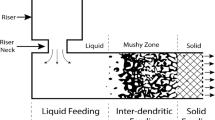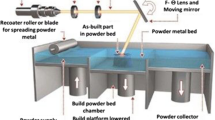Abstract
Focusing on a low price segment is usually not an option for production companies in high-wage countries. In order to stay competitive, companies have to match individual products with prices close to those of mass products. A proven instrument in reducing costs in manufacturing processes is modularization. In the die casting industry, many manufacturers already have company specific methods of modularization in their construction departments. The dies are strongly influenced by the style of the design engineers. A holistic design methodology is not yet established. To improve this current situation, a methodology for the layout of modular dies has been developed. The methodology consists of three main phases where the focus is narrowed down from company via die to component perspective. This methodology will assist the design engineers throughout the development of new dies, helping to choose an appropriate set of modules based on technical as well as economic criteria.
Similar content being viewed by others
References
Schuh G (2005) Produktionskomplexität managen, 2nd edn. Carl Hanser, Munich
Queudeville Y, Ivanov T, Nußbaum C, Vroomen U, Bührig-Polaczek A (2009) Decision and design methodologies for the lay-out of modular dies for high-pressure-die-cast-processes. Mater Sci Forum 618–619:345–348
Queudeville Y et al (2011) Design methodology for modular tools. Prod Eng. doi:10.1007/s11740-011-0318-x
Fixon SK (2007) Modularity and commonality research: past developments and future opportunities, concurrent engineering SAGE
Eitelwein O, Weber J (2008) Unternehmenserfolg durch Modularisierung von Produkten, Prozessen und Supply Chains. Book on Demand GmbH, Norderstedt
Koppenhagen F (2011) Verzahnte Produktentwicklung. Ind Manag 27(5):13–16
Göpfert J (1998) Modulare Produktentwicklung. Zur gemeinsamen Gestaltung von Technik und Organisation Dissertation. Ludwig-Maximilians-Universität München, Germany
Pahl G, Beitz W, Feldhusen J, Grote K (2007) Pahl/Beitz Konstruktionslehre: Grundlagen erfolgreicher Produktentwicklung. Springer Verlag, Heidelberg
Ulrich K (1995) The role of product architecture in the manufacturing firm. Res Policy 24:419–440
Gershenson JK, Prasad GJ, Zhang Y (2003) Product modularity: definitions and benefits. J Eng Des 15:33–51
N N (2007) Statistik Ne-Metallguss 2007, Bundesverband der Deutschen Gießerei-Industrie (BDG), p 10, Düsseldorf, Germany
Hummler-Schaufler B, Schlumpberger C (2004) Produktentwicklung auf hohem Niveau, Druckguss Praxis, pp 39-42
Lee KS, Luo C (2002) Application of case-based reasoning in die-casting die design, The International Journal of Advanced Manufacturing Technology, Springer Verlag, London, vol. 20, pp 284-295
Lin JC (2003) The optimal design of a cooling system for a die-casting die with a free form surface, The International Journal of Advanced Manufacturing Technology, Springer Verlag, London , vol. 21, pp 612-619
Wu SH, Lee KS, Fuh JYH (2002) Feature-based parametric design of a gating system for a dies-casting die, The International Journal of Advanced Manufacturing Technology, Springer Verlag, London, vol. 19, pp 821-829
Desai P, Kekre S, Radhakrishnan S, Srinivasan K (2001) Product differentiation and commonality in design: balancing revenue and cost drivers. Manag Sci INFORMS 47:37–51
Kota S, Sethuraman K, Miller R (2000) A metric for evaluating design commonality in product families. J Mech Des 122:403–410
Tang D, Eversheim W, Schuh G (2004) A new generation of cooperative development paradigm in the tool and die making branch: strategy and technology. Robot Comput Integr Manuf 20:301–311, Aachen, Germany
Mikkola JH, Gassmann O (2003) Managing modularity of product architectures: toward an integrated theory. IEEE Trans Eng Manag 50:204–218
Boos W (2008) Methodik zur Gestaltung und Bewertung von modularen Werkzeugen. Apprimus Wissenschaftsverlag, Aachen
Lindemann U, Maurer M, Braun T (2009) Structural complexity management: an approach for the field of product design. Springer Verlag, Heidelberg
Author information
Authors and Affiliations
Corresponding author
Rights and permissions
About this article
Cite this article
Queudeville, Y., Vroomen, U. & Bührig-Polaczek, A. Modularization methodology for high pressure die casting dies. Int J Adv Manuf Technol 71, 1677–1686 (2014). https://doi.org/10.1007/s00170-013-5582-9
Received:
Accepted:
Published:
Issue Date:
DOI: https://doi.org/10.1007/s00170-013-5582-9




